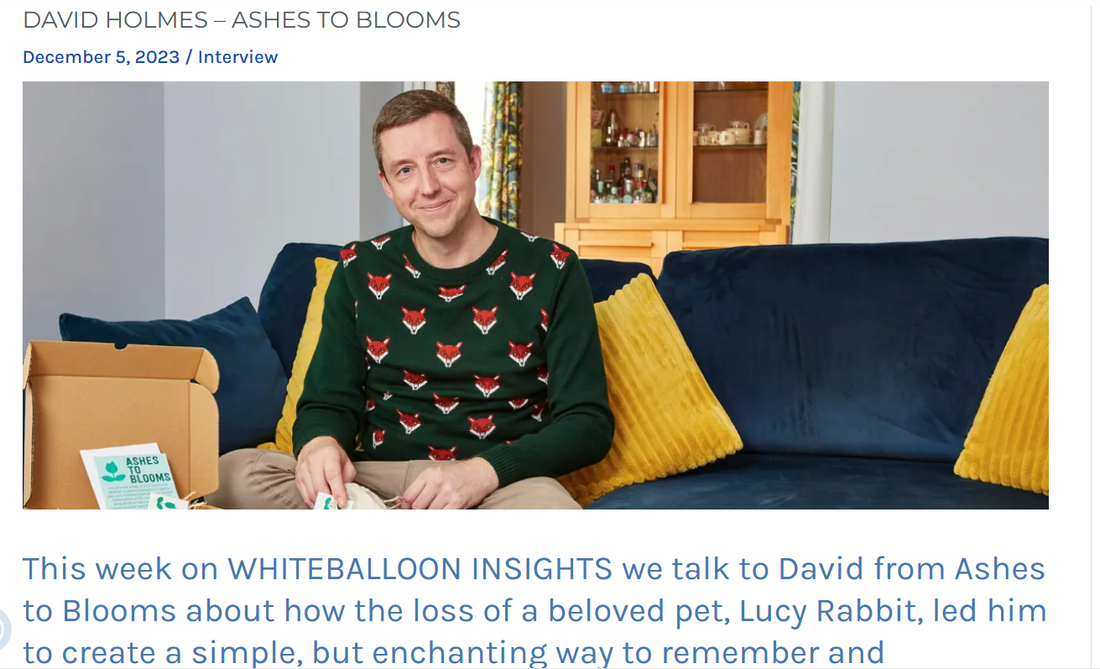This week on WHITEBALLOON INSIGHTS we talk to David from Ashes to Blooms about how the loss of a beloved pet, Lucy Rabbit, led him to create a simple, but enchanting way to remember and memorialise those we have loved and lost.
Q: Ashes to Blooms is such a simple, but lovely, concept. Do tell us more about the story behind its creation?
I was raised in a household full of animals, and so being in a home without any pets always felt wrong to me.
After a relationship breakdown in 2009 I decided that it was the right time to find a companion animal. In the summer of 2010 I was at the South of England show at Ardingly, when I came across a beautiful Netherland Dwarf rabbit, later to become known as Lucy Rabbit. I instantly knew that she was the girl for me! She came home with me that afternoon and she was the best companion for almost 12 years. Lucy lived free in my lounge and made it entirely hers; we refer to it as ‘Lucy’s Lounge’, as she was very much the boss of the domain. Lucy was full of love, enjoying strokes and cuddles, as well as being feisty and endlessly naughty.
By January 2022 Lucy Rabbit had really slowed down as a result of arthritis, and on the 27th of January 2022 I made the heart-rending decision to have her put down. I was distraught and there seemed like no way to do justice to the companion she had been and the incredible happiness and fun she brought to my life over the past almost 12 years. It was as a result of this loss that I set about creating Ashes to Blooms.
Q: How do you choose which seeds to include in the seed balls and can people select which combination of flowers they would like?
We looked at a wide variety of UK native varieties to find the combination that would give a range of colours, heights and character. We also chose varieties which liked different sorts of conditions; everyone has a unique environment in their garden, and we needed to cater to that! We also wanted varieties with interesting stories behind them and that really meant something, with our five favourites being:
Common Name: Red Corn Poppy
Latin Name: Papaver Rhoeas
Where it thrives: moist, rich soil, close to the surface
Why we love it: poppy plants produce beautiful flowers, growing in a range of colours, our favourite being the red-flowered corn poppy. Not only is it beautiful and a symbol of those we have lost, the poppy is used for the production of latex, morphine and codeine. Their seeds are also rich in oil, carbohydrates, calcium and protein, and so often used in cooking.
Common Name: Yellow Tansy or Golden Buttons
Latin Name: Tanacetum vulgare
Where it thrives: can grow in full sun or partial shade. It thrives in fertile, well-drained soil & in an area that has little vegetation already established
Why we love it: produces beautiful, yellow, button-like flowers. It has previously had many uses as a medicine (although we do not recommend this!) and continues to be used by traditional dyers to produce a golden-yellow colour and beekeepers use it as fuel in a bee smoker. In addition, it is a great companion plant to cucumber and squash plants, and adds potassium to the soil.
Common Name: Forget Me Nots
Latin Name: “Myosotis”from the Ancient Greek for “mouse’s ear”, which the foliage resembles
Where it thrives: in moist soil with good drainage, in a sunny or shady spot
Why we love it: their flowers are small, with beautiful colours including pink, white or yellow. It is used as a symbol by many, including to commemorate those lost in WW1, as well as by various Alzheimer’s organisations around the world.
Common Name: Baby’s Breath
Latin Name: “Gypsophila” from the Greek gypsos (“gypsum“) and philios (“loving“), a reference to the gypsum-rich ground in which some species grow
Where it thrives: in dry, sandy and stony places, often in chalk-rich soils
Why we love it: we use gypsum in our seed balls, for nutrient balance, and so it is integral to Ashes to Blooms. The seeds are often shaped like a snail shell, and we have noticed these seeds when making seed balls, and which resemble fossilised ammonites! These plants are also have many practical uses, including production of photographic film, soap and shampoo, as well as to absorb toxic elements from polluted soils.
Common Name: Blue Lupin or Narrow-Leaved Lupin
Latin Name: Lupinus angustifolius
Where it thrives: full sun or dappled shade, in moist but well-drained soil
Why we love it: these have been cultivated for over 6,000 years as a food crop for their seeds which are rich in protein & energy. Cleverly, the plant is also able to improve soil, fix nitrogen, uses minimal nutrients and the strong roots reduce soil compaction. As a result, the plant is a brilliant way to restore fields depleted by crop rotation.
Although we have a classic mix, we love it when people contact us and let us help to create a unique combination for them. We all have a unique relationship with plants, and everyone can have their own unique mix of varieties in their seed balls.
We have also launched a ‘shorter varieties mix’. Lots of people plant their seed balls in planters on the balconies or windowsills, and this mix is perfect for that.
Q: Do you have a background in horticulture, or is this something that you have learned more about since setting up Ashes to Blooms?
Other than helping my nan in her garden when I was younger, I have no experience in horticulture! I am a lawyer by profession, but have always had a love of nature. Since setting-up Ashes to Blooms, I have thrown myself into learning everything I can about plants and especially flowers, and am eager to keep learning.
Q: As people become more ecologically aware, have you seen increased interest in this type of memorial for a loved one?
Absolutely. I think Ashes to Blooms came about at the right time, with people becoming more and more focused on the environment. When people contact us, a key concern is often our ecological credentials, and so we do all that we can to make ours an environmentally friendly service. We love that, every time people plant our seed balls, they are creating a unique and personal wildflower memorial, and at the same supporting rewilding and biodiversity, providing food for bees, butterflies and many other insects.
Q: Why do you think living memorials like these resonate so deeply with people who are bereaved and grieving?
I had the idea after losing Lucy Rabbit, as I mentioned, and wanted to create an ecological alternative in her name. When I lost my brother, Andrew, last summer, my parents and I created seed balls for each member of our family, and we have planted these in our gardens and I planted mine in a planter on my balcony. The flowers have grown, using my brother’s ashes, and it feels like part of him is still here. I use a mixture of annual and perennial seeds, and I know that his flowers will keep growing, year after year. It’s an extremely comforting thought and means a lot to me.
Q: What future do you see for Ashes to Blooms? Would you like to expand into other forms of memorial or ways of commemorating a loved one?
My mind is full of ideas for developing Ashes to Blooms, with new products and even better ways to create ecological memorials. I am keen to make it easier for our clients to make bespoke seed combinations and to personalise their seed balls. More will be revealed about this, in the near future!
Q: And finally, do you have a special place you like to visit that lifts your spirits or that holds special memories for you?
I have always lived close to the beach, and this is a very special place for me. My brother Andrew’s seed balls are planted on my balcony, with views of the sea. Being near the sea always makes me feel that we have almost unlimited space and almost unlimited opportunities. I like the fact that the sea seems endless, and that we are actually all just very small, doing the best we can, and that we don’t actually need to worry about anything.
Thank you David for your insights.
Topics in this post: wildflower seed mix, seed bombs, native wildflower seeds, seed balls, wild flower bomb seeds, keepsakes made from ashes, what to do with ashes, wildflower memorials, wild flower memorials, ashes keepsake ideas, pet memorials, dog ashes ideas, pet ashes ideas, memorial ashes into keepsakes, remember a loved one, celebrate your pet, dog ashes ideas UK, wildflower bombs, wildflower seed bombs, wild flower seed bombs, creating a wildflower garden, make your own seed bombs, wildflower seed balls UK, wild flower seed mix bulk, wild grass seed mix, flower seed balls, flower bombs for bees, wildflower seeds for pots

